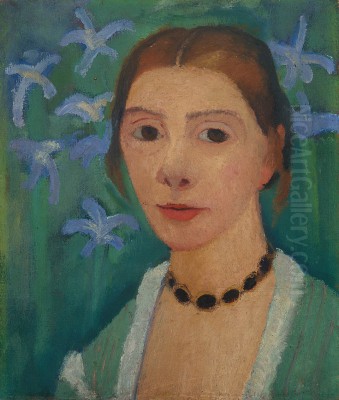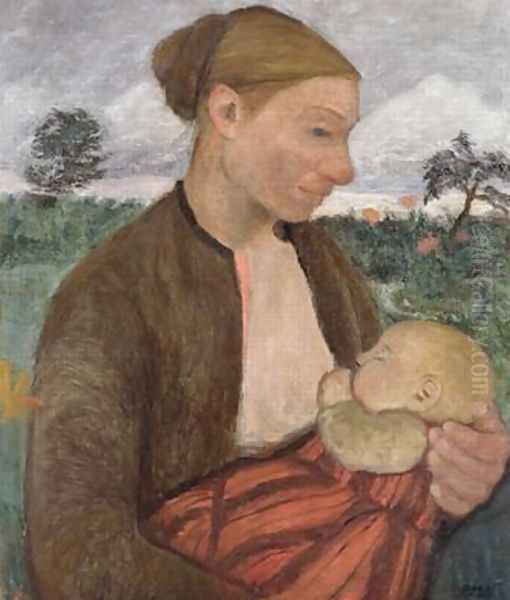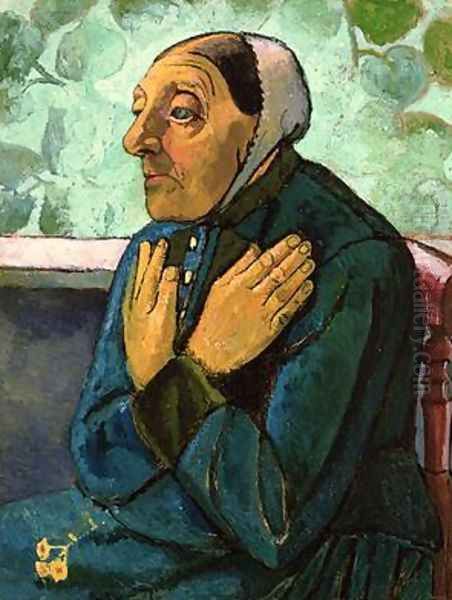
Paula Modersohn-Becker stands as a pivotal figure in the transition from late 19th-century naturalism to the burgeoning modernism of the early 20th century. A German painter whose life was tragically cut short, she is now recognized as a crucial precursor to Expressionism, leaving behind a body of work characterized by its emotional intensity, bold simplification, and groundbreaking exploration of female identity. Her unique vision, forged through experiences in the rustic Worpswede artists' colony and the vibrant art scene of Paris, resulted in paintings that continue to resonate with profound humanity and artistic daring.
Early Life and Artistic Awakening
Born Paula Becker in Dresden-Friedrichstadt in 1876, she was the third of seven children in a cultured, middle-class family. Her parents encouraged intellectual and artistic pursuits, providing an environment where her innate talent for drawing and painting could flourish from a young age. The family moved to Bremen, and it was there that Paula received her first formal instruction in drawing and painting through private lessons. This early exposure solidified her commitment to pursuing art as a vocation, a path less commonly trodden by women of her time.
Her formal training continued in Berlin, where she attended a drawing and painting school for women. However, like many aspiring artists of her generation, she felt the pull of Paris, the undisputed center of the art world. Before settling there, however, another place would prove crucial to her development: the artists' colony of Worpswede, near Bremen.
The Worpswede Years: Nature, Community, and Marriage
In 1898, Paula Becker arrived in Worpswede, an artists' colony established by painters seeking an escape from academic constraints and a closer connection to nature and rural life. Here, she initially studied under Fritz Mackensen, one of the colony's founders, whose work focused on depicting the local peasants and the stark beauty of the North German landscape. The Worpswede environment, with its peat bogs, birch trees, and agrarian community, deeply influenced her early subject matter.

Worpswede was also where she formed significant personal and artistic relationships. She developed a close friendship with the sculptor Clara Westhoff, who would later marry the poet Rainer Maria Rilke. Rilke himself became a significant figure in Paula's life, a confidant and intellectual companion. Most consequentially, she met the landscape painter Otto Modersohn, a widower and established member of the colony. They married in 1901, and she became Paula Modersohn-Becker.
Her marriage to Otto Modersohn provided a degree of financial stability but also brought complexities. While they shared a deep affection and mutual respect for each other's work, their artistic temperaments and ambitions sometimes clashed. Otto was a successful landscape painter rooted in the Worpswede aesthetic, while Paula felt an increasing urge to push beyond its limitations towards a more radical, modern form of expression. Despite finding inspiration and support within the community, she also experienced periods of isolation and frustration, yearning for the artistic stimulation of Paris. She often painted alongside Otto, sometimes tackling similar subjects, but her focus increasingly shifted towards a bolder use of color and a more monumental, simplified treatment of form, diverging from Otto's emphasis on atmospheric light and detail.
Parisian Encounters and Stylistic Metamorphosis
Paula Modersohn-Becker made several extended trips to Paris between 1900 and 1907. These visits were transformative. She immersed herself in the city's museums and galleries, studying both Old Masters and the revolutionary work of the French avant-garde. She attended classes at the Académie Colarossi and possibly the Académie Julian, seeking further instruction and exposure to new ideas.
The impact of Post-Impressionism was profound. She was deeply moved by the structural solidity and color modulation of Paul Cézanne, the bold, flat colors and expressive lines of Paul Gauguin (particularly his depictions of Tahitian women, which resonated with her interest in 'primitive' simplicity), and the raw emotional power conveyed through color and brushwork by Vincent van Gogh. She also encountered the burgeoning Fauvist movement, absorbing the radical color experiments of artists like Henri Matisse.

Her engagement was not limited to painting. She admired the powerful, expressive forms of the sculptor Auguste Rodin, whom she met through Clara Westhoff and Rilke. Furthermore, her diaries reveal a fascination with ancient art, particularly Egyptian Fayum mummy portraits and archaic Greek sculpture, whose simplified forms and directness she sought to emulate. She was aware of the broader Parisian avant-garde, which included figures like Pablo Picasso and Marcel Duchamp, even if direct stylistic influence is less overt. The influence of earlier French painters like Jean-François Millet, known for his dignified portrayals of peasant life, can also be discerned in her sympathetic treatment of rural subjects.
These diverse influences catalyzed a dramatic evolution in her style. Her brushwork became bolder, her colors more intense and less naturalistic. She increasingly simplified forms, flattening perspective and emphasizing strong outlines. Her figures gained a monumental, almost sculptural quality, conveying psychological depth and raw emotion rather than mere physical likeness. This developing style positioned her at the forefront of what would become German Expressionism, alongside artists like Ernst Ludwig Kirchner and Emil Nolde, though her path was distinctly personal.
Breaking Ground: Themes and Subjects
Paula Modersohn-Becker's subject matter, while often rooted in her Worpswede experiences, was explored with a revolutionary sensibility, particularly concerning the female figure and experience.
The Female Form and Self-Representation
Perhaps Modersohn-Becker's most radical contribution was her exploration of the female nude, particularly in her self-portraits. In 1906, during a period of separation from Otto in Paris when she contemplated ending her marriage and dedicating herself solely to art, she painted Self-Portrait on the Sixth Wedding Anniversary. This work is widely considered the first known nude self-portrait by a female artist in the history of Western art. Depicting herself semi-nude, pregnant (though she was not at the time), and gazing directly at the viewer with quiet confidence, she challenged centuries of tradition where the female nude was primarily an object of the male gaze.
Her nude self-portraits, and her nudes in general, are characterized by an earthy monumentality and a lack of conventional idealization. She portrayed the female body with honesty and strength, focusing on its elemental power and connection to nature and life cycles. These works were not merely exercises in form but profound statements about female identity, creativity, and self-possession in a world that often sought to confine women to domestic roles.
Motherhood and Childhood
Themes of motherhood and childhood held deep significance for Modersohn-Becker, reflecting both her personal longing for children and her broader artistic interest in fundamental human experiences. Works like Reclining Mother and Child and Mother and Child depict the bond between mother and infant with unsentimental tenderness and a powerful sense of primal connection. The figures are often simplified, their forms rounded and substantial, emphasizing the protective and nurturing aspects of motherhood.
Her paintings of children are equally compelling. She moved beyond sentimental Victorian depictions to capture the solemnity, vulnerability, and burgeoning individuality of her young subjects. Works such as Girl with Yellow Flower Wreath, Seated Child with Arms Crossed, Girl with Cat, Hand of an Infant, and Little Girl on a Red Checkered Pillow showcase her sensitivity to the inner lives of children. She often portrayed them with large, expressive eyes that seem to gaze directly into the viewer's soul, conveying a sense of quiet wisdom and resilience.
Peasant Life and Landscape
While initially influenced by the Worpswede school's approach to peasant subjects, Modersohn-Becker soon developed her own distinct vision. She depicted the local farmers and their families not as picturesque figures but as individuals possessing an elemental dignity and a deep connection to the land. Her painting Old Peasant Woman (c. 1903-05) is a powerful example, portraying the subject with stark honesty and psychological depth, her weathered face rendered with expressive, textured brushwork that anticipates Expressionism.
Her landscapes, too, evolved beyond mere representation. While capturing the specific atmosphere of the Worpswede region, she imbued her scenes with emotional resonance, using simplified forms and evocative color to convey feelings of solitude, vastness, or quiet contemplation. Figures are often integrated into the landscape, suggesting a harmonious, almost pantheistic relationship between humanity and nature.
Still Life
Modersohn-Becker also explored the genre of still life, using it as a vehicle for formal experimentation with color, composition, and texture. Works like Still Life with Goldfish Bowl demonstrate her ability to imbue simple objects with presence and vitality. Her approach to still life, like her other subjects, emphasized simplification and expressive potential over detailed realism, aligning with her overall modernist trajectory.
Artistic Style and Technique
Paula Modersohn-Becker's mature style is characterized by its synthesis of diverse influences into a unique and powerful personal language. Key elements include:
Simplification of Form: She reduced figures and objects to their essential shapes, often using strong outlines and flattened planes, reminiscent of Gauguin and ancient art.
Bold Use of Color: Moving away from naturalistic color, she employed intense, often earthy hues for emotional and expressive effect, influenced by Van Gogh and the Fauves.
Textured Surfaces: Her paintings often feature a rich, tactile surface, achieved through visible brushstrokes (impasto) and sometimes experimental techniques like scraping or working wet-on-wet, adding to the raw, elemental quality of her work.
Monumentality: Her figures, particularly the female nudes and mothers, possess a weighty, sculptural presence that conveys strength and permanence.
Emotional Intensity: Above all, her work is driven by a desire to express inner feeling and psychological depth, marking her as a key forerunner of Expressionism.
She worked primarily in oil on canvas or board, but also produced a large number of drawings and etchings, which further reveal her mastery of line and form. Her technique was often experimental, reflecting her constant search for the most direct and powerful means of expression.
Friendship with Rilke
The friendship between Paula Modersohn-Becker and the poet Rainer Maria Rilke was a significant intellectual and emotional connection for both artists. They met in Worpswede around 1900 and maintained a correspondence and intermittent contact, particularly during Paula's stays in Paris. They shared ideas about art, life, and the creative process. Rilke admired Paula's dedication and artistic vision.
Her sudden death deeply affected Rilke. In 1908, he composed one of his most famous elegies, Requiem for a Friend, dedicated to her memory. The poem is a profound meditation on her life, art, death, and the challenges faced by female artists. It stands as a testament to the depth of their connection and Rilke's recognition of her unique genius and unfulfilled potential.
Final Years and Tragic Death
In 1906, despite Otto Modersohn's pleas, Paula remained in Paris, determined to establish herself independently. However, Otto eventually followed her, and they reconciled. She became pregnant, fulfilling a long-held desire. They returned to Worpswede in 1907, and Paula gave birth to her daughter, Mathilde, in early November.
Tragically, just eighteen days after the birth, Paula Modersohn-Becker died suddenly from a post-partum embolism on November 20, 1907. She was only 31 years old. Her last words, reportedly uttered as she reached for a glass, were "What a pity." Her death cut short a career that was reaching its full artistic maturity, leaving behind a legacy rich in achievement yet poignant with unfulfilled promise.
Legacy and Influence
During her lifetime, Paula Modersohn-Becker achieved limited recognition. While she exhibited occasionally, her radical style was often met with incomprehension or criticism, even sometimes from her husband and fellow Worpswede artists who found her later work challenging. She struggled financially and sold very few paintings.
However, posthumously, her reputation grew steadily. Exhibitions and the publication of her letters and diaries revealed the depth and originality of her vision. She came to be recognized as one of the most important German artists of the early 20th century and a crucial figure in the development of modern art. The Paula Modersohn-Becker Museum in Bremen, opened in 1927, was the first museum in the world dedicated to a female artist.
Her influence extends in several directions. She is a foundational figure of German Expressionism, anticipating many of its stylistic and thematic concerns. Her unflinching exploration of the female body and experience has made her an icon for feminist art historians and later generations of female artists, including figures like Frida Kahlo and Cindy Sherman, who have similarly used self-representation to explore identity. Her sensitive portrayals of motherhood and childhood continue to resonate, while her bold formal innovations secure her place in the broader narrative of modern art's evolution.
Conclusion
Paula Modersohn-Becker's artistic journey was one of intense searching, courageous innovation, and profound emotional honesty. In a career spanning little more than a decade, she forged a unique visual language that bridged the gap between 19th-century traditions and 20th-century modernism. Through her powerful self-portraits, her empathetic depictions of women and children, and her evocative landscapes and still lifes, she created a body of work that challenged conventions and expanded the expressive possibilities of painting. Though her life was tragically brief, Paula Modersohn-Becker's art remains a luminous testament to her pioneering spirit and enduring vision.